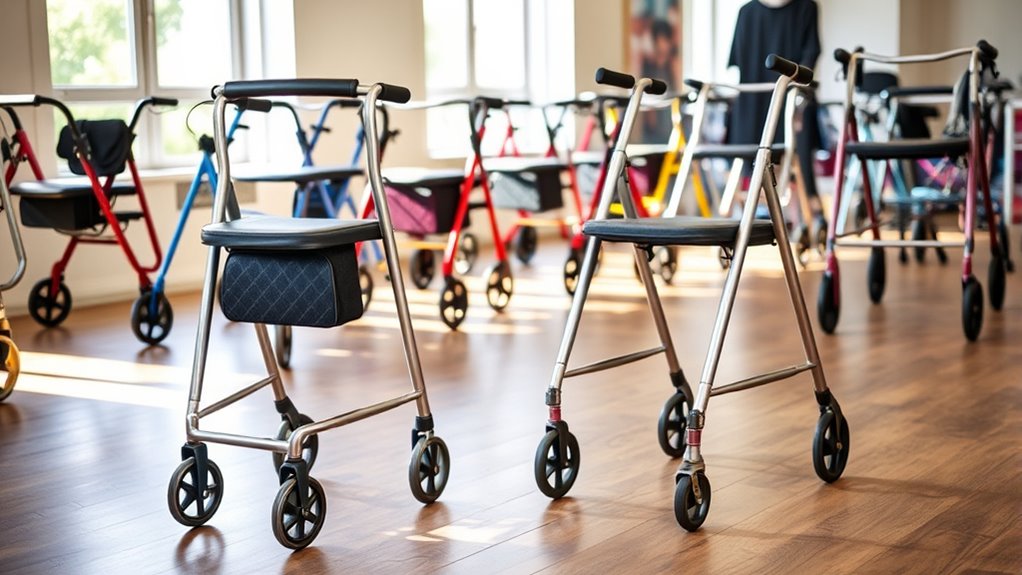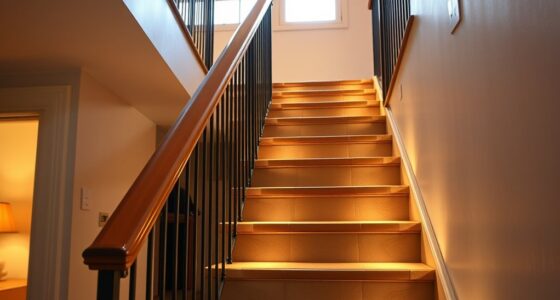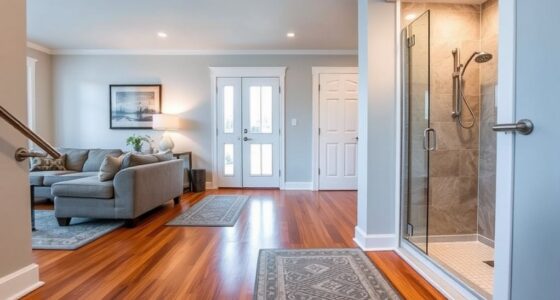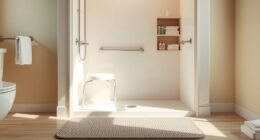To choose the right walker or rollator, consider your safety, comfort, and style preferences. Look for a device with a sleek design that matches your home’s decor and has adjustable, ergonomic handles for easy use. Prioritize stability and lightweight framing for portability and ease of movement. Make sure it fits your daily routine and space constraints. Exploring these factors will help you find a device that seamlessly blends into your lifestyle and home environment.
Key Takeaways
- Assess your mobility needs, including stability, ease of use, and specific features like storage or lights.
- Choose a design that complements your home’s interior style with sleek, neutral tones and unobtrusive features.
- Prioritize lightweight, foldable models for easy handling, storage, and portability within your living space.
- Ensure adjustable height and ergonomic handles for personalized comfort and reduced strain during use.
- Consider safety features like sturdy wheels, reliable brakes, and a wide base to enhance stability and confidence.
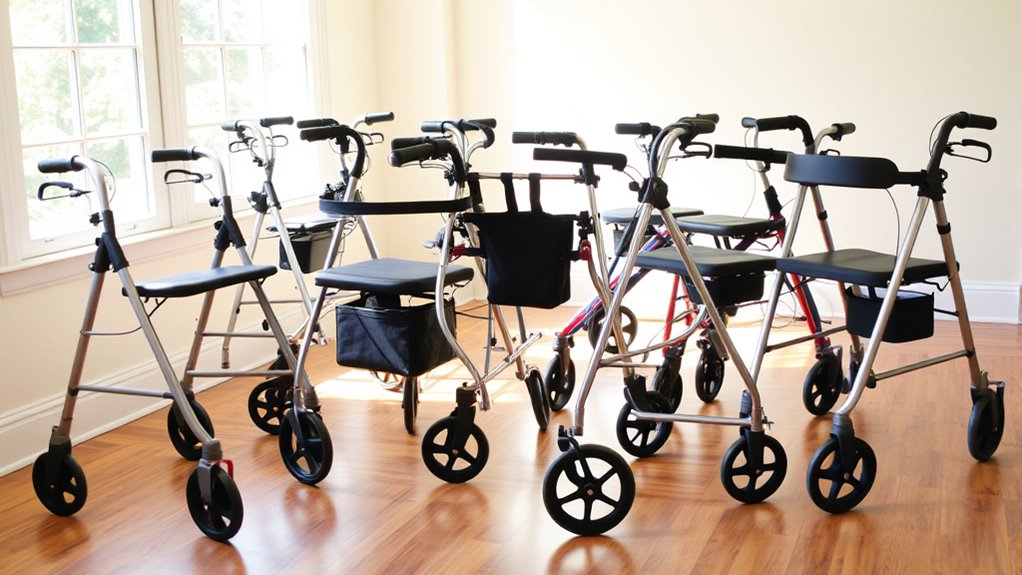
Finding the right walker or rollator can considerably improve your mobility and independence. When choosing a mobility accessory, it’s essential to consider not only functionality but also how it fits into your everyday environment. Your interior design plays a significant role in this decision because a device that complements your space can make using it feel more natural and less obtrusive. Think about the colors, materials, and overall aesthetic of your home. Many modern walkers and rollators come in sleek designs and neutral tones that blend seamlessly with various interior styles, helping you feel comfortable and confident in your surroundings.
Choose a walker or rollator that complements your home’s style for seamless, confident mobility.
As you explore different options, pay attention to how the design of the device interacts with your living space. A bulky or poorly designed walker can feel out of place, disrupting the flow of your home. On the other hand, a well-designed mobility accessory can enhance your interior design rather than detract from it. Some models feature lightweight frames, foldable components, and adjustable features that make storage and maneuvering easier, especially in tight spaces. These practical features can help you maintain a tidy and organized home while ensuring your device remains unobtrusive. Additionally, choosing a device with lightweight frames can make a significant difference in ease of handling and transport.
Comfort and stability are crucial when selecting a walker or rollator. Look for models with ergonomic handles and adjustable height settings so you can use them comfortably for extended periods. Stability features like wide bases, sturdy wheels, and reliable brakes provide safety and confidence, particularly if you have balance concerns. The right device should feel secure under your hands and support you reliably without causing strain. In addition, consider mobility accessories that enhance your device’s functionality, such as cup holders, storage pouches, or lights, which can make your daily routines more manageable and enjoyable. Incorporating ergonomic handle designs can also improve user comfort during prolonged use. Moreover, selecting a device with versatile storage options can help keep your essentials close and organized, adding convenience to your mobility.
Portability is another essential factor. If you frequently move between rooms or take outings, choose a walker or rollator that’s lightweight and easy to fold. This not only makes transportation easier but also allows you to store the device conveniently, preserving your interior design’s aesthetic. Remember, a good fit isn’t solely about physical dimensions—it’s about how well the device integrates into your lifestyle and home environment. Additionally, understanding self-watering plant pots can inspire versatile, space-efficient solutions for your home’s interior, promoting a harmonious environment.
Frequently Asked Questions
Can I Customize a Walker or Rollator for Specific Health Conditions?
Yes, you can customize a walker or rollator for your specific health conditions. Many models offer customization options and health-specific features, such as adjustable height, specialized grips, or added support for conditions like arthritis or balance issues. By discussing your needs with a healthcare professional or supplier, you can guarantee the walker or rollator includes the right customization options to enhance safety, comfort, and mobility tailored to your health requirements.
Are There Lightweight Options Suitable for Travel and Everyday Use?
Yes, there are lightweight options perfect for travel and daily use. These walkers feature a portable design that makes them easy to fold and carry. Look for models with a sufficient weight capacity to support your needs comfortably. Lightweight walkers are typically made from durable materials, ensuring stability while remaining easy to maneuver. This way, you can stay active and independent without the hassle of heavy, cumbersome equipment.
How Do I Select the Best Brake System for Safety?
Did you know that falls cause over 32,000 deaths annually among older adults? When selecting a walker or rollator, focus on brake types and safety features. Look for easy-to-use, reliable brakes like push-down or loop locks that prevent accidental slips. Prioritize models with responsive brakes that you can operate confidently, ensuring safety during stops and on uneven surfaces. Your choice of brake system directly impacts your stability and peace of mind.
What Are the Cost Differences Between Basic and Advanced Models?
When comparing basic and advanced models, you’ll notice a significant pricing difference. Basic models are more affordable, typically ranging from $50 to $150, offering essential features. Advanced models, costing $200 to $500 or more, include extra features like better brakes, adjustable height, and extra storage. The pricing comparison reflects feature differences, so consider which features matter most to you and your budget to make the best choice.
Do Walkers or Rollators Require Regular Maintenance or Repairs?
Walkers and rollators do require regular maintenance and occasional repairs to keep them functioning safely. You should follow maintenance tips like cleaning the frame, checking the wheels, and tightening loose parts regularly. If you notice issues, don’t hesitate to seek repair services promptly to prevent further damage. Proper upkeep guarantees your device remains reliable, comfortable, and safe for daily use, extending its lifespan and your independence.
Conclusion
Now that you know what to look for, the perfect walker or rollator is within your reach. But remember, choosing the right mobility aid isn’t just about features—it’s about finding what truly restores your confidence and independence. Imagine the freedom waiting just around the corner. Are you ready to take that first step? The right choice could change everything. Don’t wait—your new level of mobility is closer than you think.
